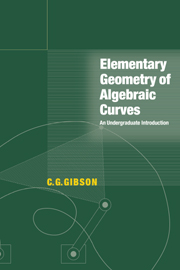Book contents
- Frontmatter
- Contents
- List of Illustrations
- List of Tables
- Preface
- 1 Real Algebraic Curves
- 2 General Ground Fields
- 3 Polynomial Algebra
- 4 Affine Equivalence
- 5 Affine Conics
- 6 Singularities of Affine Curves
- 7 Tangents to Affine Curves
- 8 Rational Affine Curves
- 9 Projective Algebraic Curves
- 10 Singularities of Projective Curves
- 11 Projective Equivalence
- 12 Projective Tangents
- 13 Flexes
- 14 Intersections of Projective Curves
- 15 Projective Cubics
- 16 Linear Systems
- 17 The Group Structure on a Cubic
- 18 Rational Projective Curves
- Index
13 - Flexes
Published online by Cambridge University Press: 05 June 2012
- Frontmatter
- Contents
- List of Illustrations
- List of Tables
- Preface
- 1 Real Algebraic Curves
- 2 General Ground Fields
- 3 Polynomial Algebra
- 4 Affine Equivalence
- 5 Affine Conics
- 6 Singularities of Affine Curves
- 7 Tangents to Affine Curves
- 8 Rational Affine Curves
- 9 Projective Algebraic Curves
- 10 Singularities of Projective Curves
- 11 Projective Equivalence
- 12 Projective Tangents
- 13 Flexes
- 14 Intersections of Projective Curves
- 15 Projective Cubics
- 16 Linear Systems
- 17 The Group Structure on a Cubic
- 18 Rational Projective Curves
- Index
Summary
This chapter is devoted to the concept of ‘flexes’ on projective curves. There is a sense in which flexes are rather akin to singularities, and share their geometric significance; for instance, curves without line components have only finitely many flexes, and can provide insight into their geometry. Let P be a simple point on a curve F in PK2. Then the intersection number of the unique tangent line L to F at P with F is ≥ 2. In general, the intersection number I(P,F,L) will be exactly two, but at exceptional points on the curve, one might expect that number to take higher values. That leads to the following definitions. The point P is a flex of F when I(P, F, L) ≥ 3; that includes the case when I(P, F, L) = ∞. Further, P is an ordinary flex when I(P,F,L) = 3, and an undulation when I(P,F,L) ≥ 4. Note that every point on a line is a flex, and that conies cannot possess flexes, so the concept is only of interest for curves of degree ≥ 3. Since intersection numbers are projective invariants, the concept of a flex (and the distinction between ordinary and higher flexes) is invariant under projective maps. Generally speaking, it is inefficient to go back to the definitions to find the flexes of a curve F.
Example 13.1 Consider the cubic curve F = y2z - x3 in Pℂ2. It is easily verified that F has a unique singular point, at Q = (0 : 0 : 1).
Information
- Type
- Chapter
- Information
- Elementary Geometry of Algebraic CurvesAn Undergraduate Introduction, pp. 162 - 172Publisher: Cambridge University PressPrint publication year: 1998
